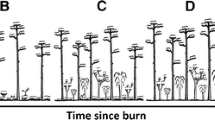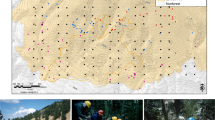Abstract
We investigate the effects of Hurricane Wilma’s storm surge (23–24 October 2005) on the dominant tree Pinus elliottii var densa (South Florida slash pine) and rare plant species in subtropical pine rocklands of the Lower Florida Keys. We examine the role of elevation on species abundance in 1995 (Hurricane Betsy in 1965), 2005 (Hurricane Georges in 1998), and 2008 (Hurricane Wilma in 2005) to investigate if hurricanes influence abundance by eliminating plants at lower elevation on Big Pine Key, the largest island in the Lower Florida Keys. We compare densities before and after Hurricane Wilma over the 2005–2008 sampling period and examine the role of elevation on changes in pine and rare species densities three years after Hurricane Wilma. We use elevation to assess the impact of hurricanes because elevation determined whether a location was influenced by storm surge (maximum surge of 2 m) in the Lower Florida Keys, where pine rocklands occur at a maximum elevation of 3 m. In 1995 (30 years after a major storm), elevation did not explain the abundance of South Florida slash pine or Chamaecrista lineata, but explained significant variation in abundance of Chamaesyce deltoidea. The latter two species are rare herbaceous plants restricted to pine rocklands. In 2008, 3 years after Hurricane Wilma, the positive relationship between elevation and abundance was strongest for South Florida slash pine, C. deltoidea, and C. lineata. Effects of Hurricane Wilma were not significant for rare species with wider distribution, occurring in plant communities adjacent to pine rocklands and in disturbed rocklands. Our results suggest that hurricanes drive population dynamics of South Florida slash pine and rare species that occur exclusively in pine rocklands at higher elevations. Rare species restricted to pine rocklands showed dramatic declines after Hurricane Wilma and were eliminated at elevations <0.5 m. Widely distributed rare species did not show significant changes in density after Hurricane Wilma. Abundance increased with elevation for South Florida slash pine and C. lineata after the hurricane. In an environment influenced by sea level rise, concrete plans to conserve pine ecosystems are warranted. Results from this study will help define conservation strategies by strengthening predictive understanding of plant responses to disturbance in the backdrop of sea level rise.
Similar content being viewed by others
References
Adler PB, HilleRisLambers J, Levine JM (2007) A niche for neutrality. Ecol Lett 10:95–104
Alexander TR, Dickson JD III (1972) Vegetational changes in the National Key Deer Refuge-II. Q J Fla Acad Sci 35:85–96
Batista WB, Platt WJ (2003) Tree population responses to hurricane disturbance: syndromes in a south-eastern USA old-growth forest. J Ecol 91:197–212
Beckage B, Gross LJ, Platt WJ (2006) Modelling responses of pine savannas to climate change and large-scale disturbance. Appl Veg Sci 9:75–82
Bergh C, Wisby J (1996) Fire history of lower Keys pine rocklands. The Nature Conservancy: unpublished document. Key West, Florida, USA
Bradley KA, Gann GD (1999) Status summaries of 12 rockland plant taxa in Southern Florida. Report submitted to U.S. Fish and Wildlife Service, Vero Beach
Bradley K, Saha S (2009) Post-hurricane responses of rare plant species and vegetation of pine rocklands in the lower Florida Keys. USFWS National Key Deer Refuge, Big Pine Key
Brown JM, Souza AJ, Wolf J (2010) Surge modelling in the eastern Irish Sea: present and future storm impact. Ocean Dyn 60:227–236
Burch DG (1966) Two new species of Chamaesyce, new combinations, and a key to the Caribbean members of the genus. Ann Mo Bot Gar 53:375–384
Busby PE, Canham CD, Motzkin G (2009) Forest response to chronic hurricane disturbance in coastal New England. J Veg Sci 20:487–497
Crossett KT, Culliton J, Wiley P (2004) Population trends along the Coastal United States, 1980–2008. National Oceanic and Atmospheric Administration, Silver Spring
Doyle TW, O’Neil CP, Melder MPV, From AS, Palta MM (2007) Tidal freshwater swamps of the southeastern United States: effects of land use, hurricanes, sea-level rise, and climate change. In: Conner WH, Doyle TW, Krauss KW (eds) Ecology of tidal freshwater forested wetlands of the Southeastern United States. Springer, Dordrecht, pp 1–28
Feehan J, Harley M, Van Minnen J (2009) Climate change in Europe. 1. Impact on terrestrial ecosystems and biodiversity: a review (Reprinted). Agron Sustai Dev 29:409–421
FEMA Hazard Mitigation Technical Assistance Program (2006) Final coastal high water mark collection for Hurricane Wilma in Florida. FEMA-1609-DR-FL, Task Order 460. Atlanta, GA, USA
Folk ML (1991) Habitat of the Key Deer. Ph.D. Dissertation, Soutern Illinois University, Carbondale
Francis H (2010) http://www.fs.fed.us/global/iitf/pdf/shrubs/Strumpfia%20maritima.pdf. Accessed 23 Feb 2010
Gann GD, Bradley KA, Woodmansee SW (2002) The rare plants of South Florida: their history, conservation and restoration. The Institute for Regional Conservation, Miami
Harcombe PA, Mann LE, Elsik IS (2009) Effects of hurricane rita on three long-term forest study plot in East Texas. Wetlands 29:88–100
Harrell FE (2001) Regression modeling strategies. Springer, New York
Herndon A (1993) A revision of the Chamaesyce deltoidea (Euphorbiaceae) complex of southern Florida. Rhodora 95:38–51
Hodges SR, Bradley KA (2006) Distribution and population size of five candidate plant taxa in the Florida Keys. Report submitted to U.S. Fish and Wildlife Service, Vero Beach
Hopkinson CS, Lugo AE, Alber M et al (2008) Forecasting effects of sea-level rise and windstorms on coastal and inland ecosystems. Front Ecol Environ 6:255–263
Imbert D, Portecop J (2008) Hurricane disturbance and forest resilience: assessing structural vs. functional changes in a Caribbean dry forest. For Ecol Manag 255:3494–3501
Lenoir J, Gegout JC, Marquet PA et al (2008) A significant upward shift in plant species optimum elevation during the 20th century. Science 320:1768–1771
Lugo AE (2000) Effects and outcomes of Caribbean hurricanes in a climate change scenario. Sci Total Environ 262:243–251
Lugo AE (2008) Visible and invisible effects of hurricanes on forest ecosystems: an international review. Austral Ecol 33:368–398
Middleton BA (2009) Regeneration of coastal marsh vegetation impacted by hurricanes Katrina and Rita. Wetlands 29:54–65
Miller TE, Gornish E, Buckley H (2009) Climate and coastal dune vegetation: disturbance, recovery and succession. Plant Ecol 206:97–104
Morrison LW (2003) Plant species persistence and turnover on small Bahamian islands. Oecologia 136:51–62
Morrison LW, Spiller DA (2008) Patterns and processes in insular floras affected by hurricanes. J Biogeogr 35:1701–1710
Neumann CJ, Jarvinen BR, Pike AC et al (1987) Tropical cyclones of the North Atlantic Ocean, 1971–1986. National Climatic Data Center in cooperation with the National Hurricane Center, Coral Gables
O’Hara RB, Kotze DH (2010) Do not log transfer count data. Methods Ecol Evol 1:118–122
Penland S, Connor PF, Beall A (2005) Changes in Louisiana’s shoreline: 1855–2002. J Coast Res 44:S7-S39
Pimm SL, Davis GE, Loope L (1994) Hurricane Andrew. BioScience 44:224–239
R Development Core Team (2009) R: A language and environment for statistical computing. R Development Core Team, Vienna
Rosenzweig C, Casassa G, Karoly DJ et al (2007) Assessment of observed changes and responses in natural and managed systems. In: Parry ML, Canziani OF, Palutikof JP, van der Linden PJ, Hanson CE (eds) Climate change 2007: impacts, adaptation and vulnerability. Contribution of Working Group II to the Fourth Assessment Report of the Intergovernmental Panel on Climate Change. Cambridge University Press, Cambridge, pp 79–131
Ross MS, Ruiz PL (1996) A study of the distribution of several south Florida endemic plants in the Florida Keys. Unpublished report to the U.S. Fish and Wildlife Service. Southeast Environmental Research Program, Florida International University, Miami
Ross MS, Obrien JJ, Sternberg LDL (1994) Sea-level rise and the reduction in pine forests in the Florida Keys. Ecol Appl 4:144–156
Ross MS, Coultas C, Hsieh YP (2003) Soil-productivity relationships and organic matter turnover in dry tropical forests of the Florida Keys. Plant Soil 253:479–492
Ross MS, O’Brien JJ, Ford RG et al (2009) Disturbance and the rising tide: the challenge of biodiversity management for low island ecosystems. Front Ecol Environ 7:471–478
Sah J, Ross MS, Snyder JR et al (2010) Tree mortality following prescribed fire and a storm surge event in slash pine (Pinus elliottii var. densa) Forests in the Florida Keys, USA. Int J For Res 2010:204795. doi:10.1155/2010/204795
Saha AK, Sternberg LDSL, Miralles-Wilhelm F (2009) Linking water sources with foliar nutrient status in upland plant communities in the Everglades National Park, USA. Ecohydrol 2:42–54
Scatena FN (1995) Relative scales of time and effectiveness of watershed processes in a tropical montane rain forest of Puerto Rico. Geophys Monogr 89. American Geophysical Union, Washington DC, pp 103–111
Scatena FN, Lugo AE (1995) Geomorphology, disturbance, and the soil and vegetation of two subtropical watersheds of Puerto Rico. Geomorphol 13:199–213
Scheffer M, Carpenter S, Foley JA (2001) Catastrophic shifts in ecosystems. Nature 413:591–596
Simpson L (1982) History of Big Pine Key, Florida, 1873–1982. Mayfield Printing Company, Kentucky
Small JK (1913) Flora of the Florida Keys. Small, New York
Small JK (1933) Manual of the Southeastern Flora. Small, New York
Smith TJ, Anderson GH, Balentine K (2009) Cummulative impacts of hurricanes on Florida Mangrove ecosystems: sediment deposition, storm surges and vegetation. Wetlands 29:24–34
Smith JM, Cialone MA, Wamsley TV et al (2010) Potential impact of sea level rise on coastal surges in southeast Louisiana. Ocean Eng 37:37–47
Snyder RL, Boss CL (2002) Recovery and stability in Barrier Island plant communities. J Coast Res 18:530–536
Snyder JR, Herndon A, Robertson WB (1990) South Florida rockland. In: Myers RL, Ewel JJ (eds) Ecosystems of Florida. University of Central Florida Press, Orlando, pp 230–277
Snyder JR, Ross MS, Koptur S (2005) Developing ecological criteria for prescribed fire in South Florida Pine Rockland Ecosystems. Final Report accessed on May 3, 2009
Somerfield PJ, Jaap WC, Clarke KR et al (2008) Changes in coral reef communities among the Florida Keys, 1996–2003. Coral Reefs 27:951–965
Sternberg LSL, Teh SY, Ewe E et al (2008) Competition of hardwood hammock and mangrove vegetation. Ecosyst 10:648–660
Stive MJF (2004) How important is global warming for coastal erosion? An editorial comment. Clim Change 64:27–39
Teh SY, DeAngelis DL, Sternberg LSL et al (2008) Disturbance events can cause regime shifts between vegetation types: a model study of mangroves and hardwood hammocks. Ecol Model 213:245–256
Ugarte CA, Brandt LA, Melvin S et al (2006) Hurricane impacts to tree islands in Arthur R. Marshall Loxahatchee National Wildlife Refuge, Florida. Southeastern Naturalist 5:737–46
Venable WN, Ripley BD (2002) Modern applied statistics with S, 4th edn. Springer, New York
Vuong QH (1989) Likelihood ratio tests for model selection and non-nested hypotheses. Econom 57:307–333
Williams K, MacDonald M, Sternberg LDL (2007) Interactions of storm, drought, and sea-level rise on coastal forest: a case study. J Coast Res 19:1116–1121
Author information
Authors and Affiliations
Corresponding author
Rights and permissions
About this article
Cite this article
Saha, S., Bradley, K., Ross, M.S. et al. Hurricane effects on subtropical pine rocklands of the Florida Keys. Climatic Change 107, 169–184 (2011). https://doi.org/10.1007/s10584-011-0081-1
Received:
Accepted:
Published:
Issue Date:
DOI: https://doi.org/10.1007/s10584-011-0081-1




